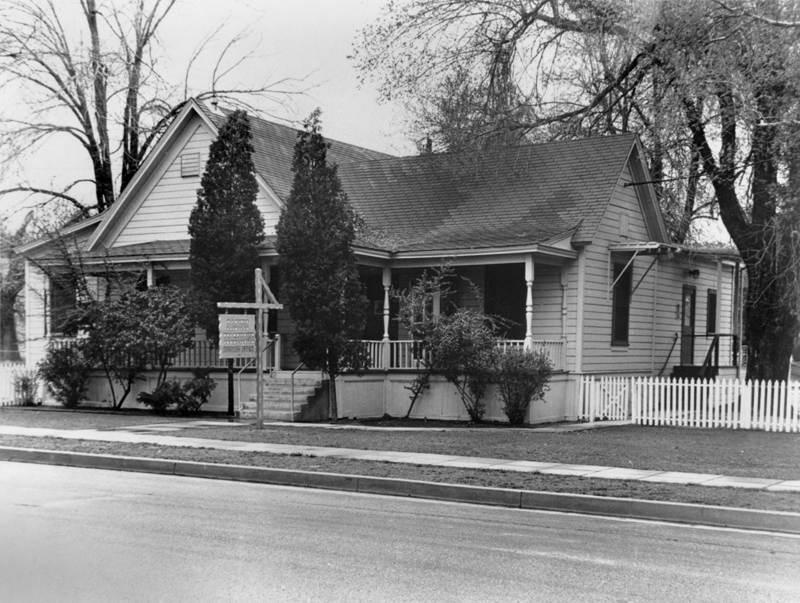
This photograph accompanied Perkins' story in the Sentinel. His caption reads: "Old Landmark —
Telephone Co. Business Office sits sedately as the years go by." (Click for more.)
|
Every Newhall landmark seems to have some bull-dozer waiting around the corner to junk the job for the trash dump. Sometimes, a story gets carted away with the remnants.
Take the Telephone Business Office — you know, the old building (24275 Walnut St.) It practically shudders every time a big cat passes by. It has a plenty long memory.
Away back in 1869 "a curious collection of 500 political non-entities from twenty states ... formed the National Prohibition Party." (Quoted from "How Dry We Were," Mr Henry Lee, Prentice-Hall 1963).
Later these "non-entities" enacted the Dry Laws, but no one seemed to bother enforcing them.
In 1889, a syndicate headed by Gov. St. John, of Kansas, titular head of the Prohibition movement, contracted for some 10,000 acres of the Newhall ranch, southerly from Saugus, to be developed as a Prohibitionist Colony.
California's Real Estate "Boom of the Eighties" busted before the colony could get started, but the syndicate hopefully imported H. Clay Needham, a political bed-fellow, to develop, or salvage, their project. What more logical that a by-product would be a Good Templar Lodge for his new location?
The new organization successfully sweat [sic] up their "Lodge Hall" on Pine St., just south of Market. But group ties proved tenuous. Some folks left for greener pastures, others simply lost interest. Whatever there was of a Lodge Hall got deserted and idled.
Ed Pardee, an '82 import from Pennsylvania's oil fields, got tired of strong-backing derrick floors up in Pico Canyon, reformed and started his livery layout at the NE Spruce (San Fernando Road) Market corner. It was an 1890 success story, but Pardee's little rented home (24303 Walnut St.) wasn't providing [sic] entirely adequate.
Over on Pine St. was that idle Hall.
Ed gobbled it up, along with the Constable's job, the old Southern Hotel lots, and unburned buildings, and other properties nobody seemed to want. Newhall was then only a dribble of maybe two dozen "board & batts," Eighth, to Market to Pine Sts. Building wrecking those days was for salvage only.
The Hall went for a walk over to Ed's Market St. triangle in the nineties, survived some remodeling and enlarging, and became the Pardee home. After Ed's death, it was the home of his daughter, Pearl Russell.
There used to be a little "guest house," or cabin, in the backyard which was for some years the headquarters of Tom Mix and his early movie activities.
The home itself was quite a social center for Pearl's friends, till about 1942, when it was sold to the Telephone Company.
It was a good central location. Functionally there were problems. Wartime made "making-do" patriotic. Besides nails were available only a pound at a time. Lots of things one wanted weren't.
You see, the telephone switch board, then at 24265 San Fernando Road had plumb busted at the seams. When installed, in the building Al Swall built for it, it had been a big improvement over the first little Board in Rudolph Henry's tailor shop (present site of Hubbard's); adequate only for the possibly four hundred folks of the village that was, in the early twenties.
Swall's housing, and the Telephone services were adequate, altho subject to constantly expanding service demands, till World War 2 upset the apple cart. Folks didn't really care about the antiquated building — if they could get service.
By 1961, the shell of the Templar lodge couldn't even house the equipment vitally necessary for 'phone service.
Newhall's booming growth was getting under way.
There was a remodeling of the Newhall Ave./Oak St. Plant including modern switch boards. The Templar's Hall was demoted to the "Business Office," and the town's telephone system transferred to new equipment in a modern building at 24705 No. Newhall Ave.
Webmaster's note.
The same photograph was published two days earlier in the Compass, which appears to have been a Pasadena-based organ of Pacific Telephone & Telegraph.
Its caption includes dates which are consistent with Perkins' story: The telephone company bought the building in 1942 "for use as the Newhall central office.
In 1961 it became the town's telephone business office and has served as such since."
The Santa Clarita Sentinel was a short-lived newspaper first published in October 1963 by Mint Canyon leader Arthur W. "Art" Evans, who coined the term "Canyon Country" and founded the annual Frontier Days celebration that same year.
A.B. Perkins penned a local history series for the Sentinel in 1964 and 1965.









